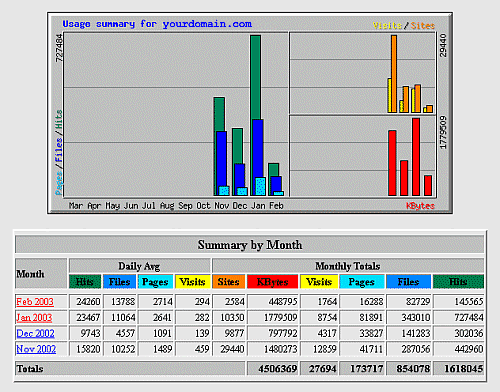Site
Statistics 
A Bizhand.Com hosting solution comes with
comprehensive site statistics that allow you to see how your site is
performing. These statistics are accessed through your web browser
and are updated by the server each evening in the middle of the night.
By going to your statistics URL you'll see that there are a variety
of linked tables and graphs that will tell you information about your
site. Use the quick overview below to get a better understanding
of the basics and contact us if you'd like more detail.
Once
your domain has been active on the Bizhand.Com server for around
48 hours and received some visits you will have stats
generated
for your
site. These are updated every 24 hours and give detailed
statistics about people visiting your site.

On your site you may click on a month to view more detailed statistics.
The main headings within the webalizer pages are as follows:
HITS
Hits represent the total number of requests made to the server during the
given time period (month, day, hour etc..).
FILES
Files represent the total number of hits (requests) that actually resulted
in something being sent back to the user. Not all hits will send data,
such as 404-Not Found requests and requests for pages that are already
in the browsers cache.
SITES
Sites is the number of unique IP addresses/hostnames that made requests
to the server. Care should be taken when using this metric for anything
other than that. Many users can appear to come from a single site, and
they can also appear to come from many ip addresses so it should be used
simply as a rough gauge as to the number of visitors to your server.
VISITS
Visits occur when some remote site makes a request for a page on your server
for the first time. As long as the same site keeps making requests within
a given timeout period, they will all be considered part of the same Visit.
If the site makes a request to your server, and the length of time since
the last request is greater than the specified timeout period (default
is 30 minutes), a new Visit is started and counted, and the sequence repeats.
Since only pages will trigger a visit, remote sites that link to graphic
and other non-page URLs (we wish they wouldn't do that!) will not be counted
in the visit totals, reducing the number of false visits.
PAGES
Pages are those URLs that would be considered the actual page being requested,
and not all of the individual items that make it up (such as graphics and
audio clips). Some people call this metric page views or page impressions.
KBYTE
A KByte (KB) is 1024 bytes (1 Kilobyte). Used to show the amount of data
that was transferred between the server and the remote machine, based on
the data found in the server log.
Some common definitions:
A Site is a remote machine that makes requests to your server, and
is based on the remote machines IP Address/Hostname.
URL - Uniform Resource Locator. All requests made
to a web server need to request something. A URL is that
something, and represents an object somewhere on your server,
that is accessible to the remote user, or results in an
error (ie: 404 - Not found). URLs can be of any type (HTML,
Audio, Graphics, etc...).
Referrers are those URLs that lead a user to your
site or caused the browser to request something from your
server. The vast majority of requests are made from your
own URLs, since most HTML pages contain links to other
objects such as graphics files. If one of your HTML pages
contains links to 10 graphic images, then each request
for the HTML page will produce 10 more hits with the referrer
specified as the URL of your own HTML page.
Search Strings are obtained from examining the referrer
string and looking for known patterns from various search
engines.
User Agents are a fancy name for browsers. Netscape,
Opera, Konqueror, etc.. are all User Agents, and each reports
itself in a unique way to your server. Keep in mind however,
that many browsers allow the user to change it's reported
name, so you might see some obvious fake names in the listing.
Entry/Exit pages are those pages that were the first
requested in a visit (Entry), and the last requested (Exit).
These pages are calculated using the Visits logic above.
When a visit is first triggered, the requested page is
counted as an Entry page, and whatever the last requested
URL was, is counted as an Exit page. |
|
|
 |






